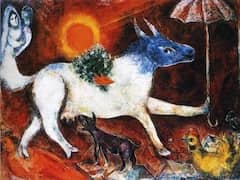Night, 1953 - by Marc Chagall

Beginning in May 1946, after an absence of six years, Chagall stayed for three months in Paris and again fell completely under the city's magic spell. During these months he made a large number of gouaches and pastels, mostly on black paper, which celebrated the optical sensations of this re-encounter like a fireworks display. After the visit ended, however, they were left to rest in their folders. But after Chagall had returned to France in 1948 and had settled in Provence, he developed the plan celebrating his joyful re-encounter with Paris in a series of pictures. As so often happened with him, his love for this city, although constantly rekindled by frequent if brief visits there, became transfigured in the distance of memory. He picked up his pastels from the summer of 1946 again, was fascinated by the fluorescent sheen of the chalk on the black ground, and made a few more random pastel sketches. At the beginning of 1952 he began work on the Parisian series, and continued on it for two whole years. The result was close to thirty pictures.
Night stems directly from one of the pastels on a black ground. The picture was important for Chagall; not only was it succeeded in the following years by a smaller variant, Red Nude, but it was also the starting point for one of the loveliest Parisian dreams, The Seine Bridges of 1954.
Upon a nocturnal and almost monochromatic ground, the picture shows a pair of lovers flying across the sky, accompanied by a somersaulting cock. To the right opens a window. A table with a basket of fruit, a vase of flowers, and a bottle and glass suggests an interior, as if the loving couple were flying away from the festive table, through the window, and into the night sky of Paris. Yet the inside and the outside are completely interchangeable, as is often true in a dream, and the pair also seems to float in a phosphorescent ballet over the midnight Seine, spanned by the arches of a golden bridge, near which the Eiffel Tower stands like a glittering exclamation mark. This is a lighthearted festive metaphor of Paris, which the French are so fond of calling la ville lumiere.
The fluorescent gleam of the color, which conveys in oil painting the effect of pastels on dark paper - and which appears with such sharpness only in this picture - makes us aware of the numerous color problems which challenged Chagall after his return to France. His experimentation with the possibilities of color were also carried on with the enamel colors of ceramic glazes, glowing deeply with a luster coming from the material itself, and with the flat color planes of lithography, on which Chagall had been working very intensively since 1951. In fact, the problems of color and the construction of the picture from color have increasingly occupied the center of Chagall's pictorial activity ever since the quiet work in his new studio in Vence began.
















